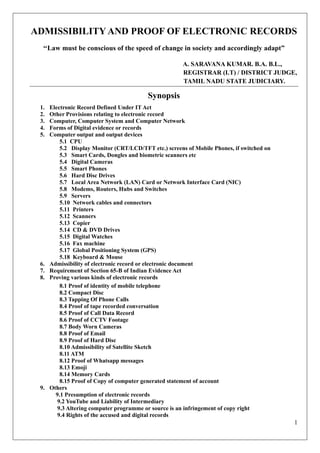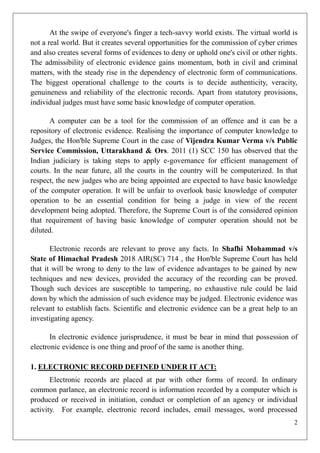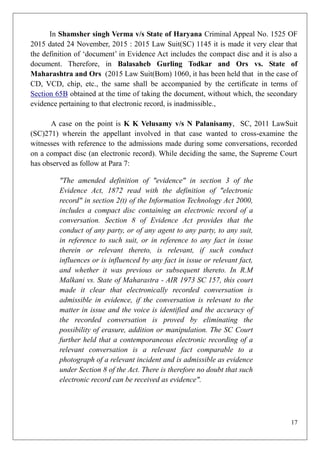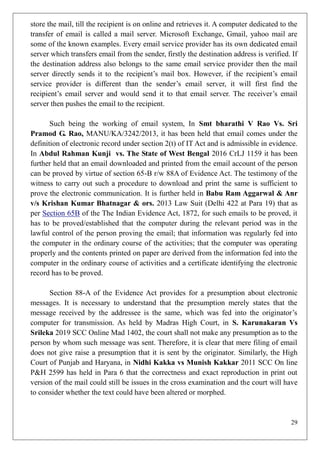This document discusses the admissibility and proof of electronic records in court. It defines key terms related to electronic records under the Information Technology Act such as electronic record, data, computer, computer system, and computer network. It outlines various forms of digital evidence that can be obtained from electronic devices and computer outputs. It explains the requirements for proving electronic records in court according to Section 65B of the Indian Evidence Act. Overall, the document provides information on establishing the authenticity and admissibility of different types of electronic records as evidence in legal proceedings.




![5
While interpreting Section 2(1) of the IT Act, in Syed Asifuddin V/S State of
Andhra Pradesh 2006 (1) ALD Cri 96: 2005 CriLJ 4314 it has been observed in Para
12 that a reading of clauses (i), (j) and (1) of Section 2(1) of the I.T. Act would show
that any electronic, magnetic or optical device used for storage of information received
through satellite, microwave or other communication media and the devices which are
programmable and capable of retrieving any information by manipulations of electronic,
magnetic or optical impulses is a computer which can be used as computer system in a
computer network.
Computers work through source code. It is the source of a computer. It contains
declaration, instructions, functions, loops and other statements which act as instruction
for the program on how to function. While dealing with Computer source code, it has
been stated in Syed Asifuddin v/s State of Andhra Pradesh 2006 (1) ALD Cri 96:
2005 CriLJ 4314, in Para 13 that a computer has to be appropriately instructed so as to
make it work as per its specifications. The instructions issued to the computer consists
of a series of OS and is in different permutations and combinations. This machine
language can be in different forms in different manner, which is called computer
language. The communicator as well as the computer understand "a language" and
mutually respond with each other. When specified or particular instructions are given,
having regarded to the capacity of the computer it performs certain specified functions.
The instructions or programme given to computer in a language known to the computer
are not seen by the users of the computer/consumers of computer functions. Known as
source code in computer parlance, the programme written in whatever computer
language by the person who assembled the programme are not seen by the users. A
source code is thus a programme as written by the programmer. Every computer
functions as a separate programme and thus a separate source code.
It has been further observed in Para 14 of the above judgment that computer
source code or just source or code may be defined as a series of statements written in
some human readable computer programming language constituting several text files
but the source code may be printed in a book or recorded on a tape without a file
system, and this source code is a piece of computer software. The same is used to
produce object code. But a programme to be run by interpreter is not carried out on
object code but on source code and then converted again. [Diane Rowland and Elizabeth
Macdonald: Information Technology Law; Canandish Publishing Limited; (1997). p.
17] Thus, source code is always closely guarded by the computer companies, which
develop different function specific computer programmes capable of handling various
types of functions depending on the need. The law as we presently see is developing in](https://image.slidesharecdn.com/electronicrecordsarticle-231203163642-755e1912/85/electronic_records_article-pdf-5-320.jpg)









![15
frequency pair that is used by the receiver cell phone.] Another
advantage in a cell phone compared with radio phone is that when
the radio phone is used, one person can talk at a time as both the
persons can communicate simultaneously and also receive sound
signals simultaneously.
All cell phone service providers like Tata Indicom and Reliance
India Mobile have special codes dedicated to them and these are
intended to identify the phone, the phone's owner and the service
provider. To understand how the cell phone works, we need to
know certain terms in cell phone parlance. System Identification
Code (SID) is a unique 5-digit number that is assigned to each
carrier by the licensor. Electronic Serial Number (ESN) is a
unique 32-bit number programmed into the phone when it is
manufactured by the instrument manufacturer. Mobile
Identification Number (MIN) is a 10-digit number derived from
cell phone number given to a subscriber. When the cell phone is
switched on, it listens for a SID on the control channel, which is a
special frequency used by the phone and base station to talk to one
another about things like call set-up and channel changing. If the
phone cannot find any control channels to listen to, the cell phone
displays "no service" message as it is out of range. When cell
phone receives SID, it compares it to the SID programmed into the
phone and if these code numbers match, cell knows that it is
communicating with its home system. Along with the SID, the
phone also transmits registration request and MTSO which keeps
track of the phone's location in a database, knows which cell
phone you are using and gives a ring. When MTSO gets a call
intended to one.
The essential functions in the use of cell phone, which are
performed by the MTSO, is the central antenna/central transmitter
and other transmitters in other areas well coordinated with the
cell phone functions in a fraction of a second. All this is made
possible only by a computer, which simultaneously receives,
analyses and distributes data by way of sending and receiving
radio/electrical signals.
So as to match with the system of the cell phone provider, every
cell phone contains a circuit board, which is the brain of the](https://image.slidesharecdn.com/electronicrecordsarticle-231203163642-755e1912/85/electronic_records_article-pdf-15-320.jpg)
![16
phone. It is a combination of several computer chips programmed
to convert analog to digital (Analog - Anything analogous to
something else).
Analog computer - A computing machine so designed and constructed as to provide
information in terms of physical quantities analogous to those in which the problems are
formulated.
Digital - 1. Of, pertaining to, or like the fingers or digits 2. Digitate. 3. Showing
information, such as numerals, by means of electronics: digital watches.
Digital computer - An electronic computing machine which receives problems and
processes the answers in numerical form, especially one using the binary system. (See
"The New International Webster's Comprehensive Dictionary of the English Language",
Encyclopeadic Edition, 2003 edn., pp. 52 and 358).] and digital to analog conversion
and translation of the outgoing audio signals and incoming signals. This is a micro
processor similar to the one generally used in the compact disk of a Desktop computer.
Without the circuit board, cell phone instrument cannot function.
Such being the functionality of a cell phone, the question is whether a cell phone
is a computer? In Syed Asifuddin (stated supra) it is held that it is not possible to accept
the submission that a cell phone is not a computer. Even by the very definition of the
computer and computer network as defined in IT Act, a cell phone is a computer which
is programmed to do among others the function of receiving digital audio signals,
convert it into analog audio signal and also send analog audio signals in a digital form
externally by wireless technology.
As to burden of proof, in the case of Arun Maruthi Wahchaure Vs State of
Maharastra, Crl Appeal No. 1291 of 2012 dated 19.3.2015, at page 13, it has been laid
down that whenever the identity of mobile number is questioned, it is the duty of the
investigation agency to prove the IMEI number of the mobile instrument number.
Therefore, it is clear that identity of the mobile number can be proved by proving IMEI
number.
8.2 COMPACT DISC:
A compact disc is a portable storage medium that can be used to record, store and
play back audio, video and other data in digital form. It is available in many formats like
CD-ROM, CD-I (inter active), CD-RW (re writable), CD-R (Recordable), Photo CD,
and Video CD etc.,](https://image.slidesharecdn.com/electronicrecordsarticle-231203163642-755e1912/85/electronic_records_article-pdf-16-320.jpg)









![26
6. The voice of the speaker should be clearly audible and not
lost or distorted by other sounds or disturbances.
While deciding the evidentiary value of tape recorded conversation, in Yusufalli
Esmail Nagree v. State of Maharashtra [1967] 3 S.C.R. 720 it has been reiterated that
if a statement is relevant, an accurate tape record of the statement is also relevant and
admissible. The time and place and accuracy of the recording must be proved by a
competent witness and the voices must be properly identified. One of the features of
magnetic tape recording is the ability to erase and re-use the recording medium.
Because of this facility of erasure and re-use, the evidence must be received with
caution. The court must be satisfied beyond reasonable doubt that the record has not
been tampered with. The tape was not sealed and was kept in the custody of Mahajan.
The absence of sealing naturally gives rise to the argument that the recording medium
might have been tempered with before it was replayed. In N. Sri Rama Reddy, etc. v.
V.V.Giri [1971] 1 S.C.R at page 399, it is further observed as follows:
"Having due regard to the decisions referred to above, it is
clear that a previous statement, made by a person and recorded
on tape, can be used not only to corroborate the evidence given
by the witness in Court but also to contradict the evidence given
before the Court, as well as to test the veracity of the witness
and also to impeach his impartiality.
8.5 Proof of Call Data Record:
A Call Data Record is a detailed record of SMS and calls that are sent and
received by a subscriber of a service provider. The main benefits we can reap from Call
Detail Record are identifying the suspect’s day location , night location, handset details,
maximum contact number, date, time , tower location at the time of occurrence of the
offence, coordinates of his movement etc., It can also be disseminate the details
regarding call duration, connection status, source number, destination number, accurate
identification of telephone exchange, unique sequence number identifying the record,
the route by which the call entered the exchange, the route by which the call left the
exchange.
Regarding the proof and admissibility of mobile phone call records, it needs to be
proved by producing certificate under Section 65-B of Evidence Act. In Bala Saheb
Gurling Todkari Vs. State of Maharastra (2015 SCC Online Bom 3360) it has been
held in Para 36 that absence of certificate would render the CDR inadmissible in law.
Being inadmissible it cannot be considered. However, in State of NCT of Delhi Vs](https://image.slidesharecdn.com/electronicrecordsarticle-231203163642-755e1912/85/electronic_records_article-pdf-26-320.jpg)






![33
9. Others :
9.1 Presumption of electronic records:
Section 81-A of Indian Evidence Act deals about presumption as to genuineness
of electronic records. It says that genuineness of the electronic record shall be presumed
in respect of official gazette or purporting to be electronic records directed by any law to
kept by any person if such record is kept substantially in the form required by law and is
produced from proper custody.
9.2 YouTube and Liability of Intermediary:
It is further held that the basic function of the YouTube website permits users to
"upload" and view video clips free of charge. Before uploading a video to YouTube, a
user must register and create an account with the website. The registration process
requires the user to accept YouTube's Terms of Use agreement, which provides, inter
alia, that the user "will not submit material that is copyrighted ... unless [he is] the
owner of such rights or ha[s] permission from their rightful owner to post the material
and to grant YouTube all of the license rights granted herein." When the registration
process is complete, the user can sign in to his account, select a video to upload from the
user's personal computer, mobile phone, or other device and instruct the YouTube
system to upload the video by clicking on a virtual upload "button." The same is the
procedure in Google Website. Thus, if the actual knowledge to the intermediary is
proved, then intermediary cannot escape its liability. (at Para 87, Google India Private
Limited V/S Visaka Industries Limited And 2 Others, 2016 Law Suit (Hyd) 548)
9.3 Altering computer programme or source is an infringement of copy right:
Therefore, reading Section 2(o), (ffc) and Sections 13 and 14 together, it becomes
clear that a computer programme is by very definition original literary work and,
therefore, the law protects such copyright. Under Section 63 of the Copyright Act, any
infringement of the copyright in a computer programme/source code is punishable.
Therefore, prima facie, if a person alters computer programme of another person or
another computer company, the same would be infringement of the copyright.
9.4 Rights of the accused and digital records:
Once we deal about proof of electronic records, it is equally important that
opportunity must be given to disprove it. Needless to say, right to fair trial is a
fundamental right and valuable right to an accused. In Manu sharma Vs State NCT of
Delhi (2010)6 SCC 1, it has been observed in Para 220 that the right of the accused with
regard to disclosure of document is a limited right but it is codified and is the foundation](https://image.slidesharecdn.com/electronicrecordsarticle-231203163642-755e1912/85/electronic_records_article-pdf-33-320.jpg)
